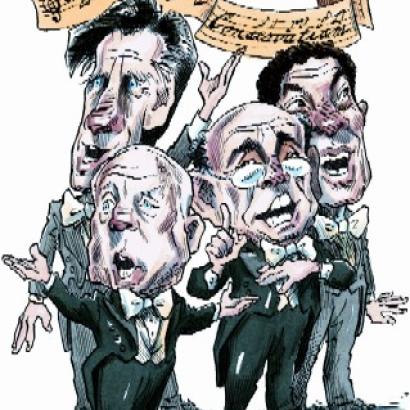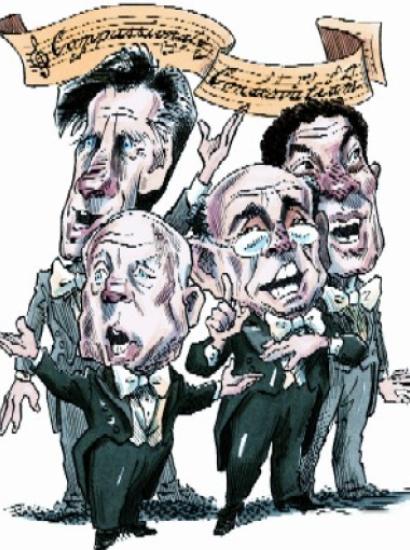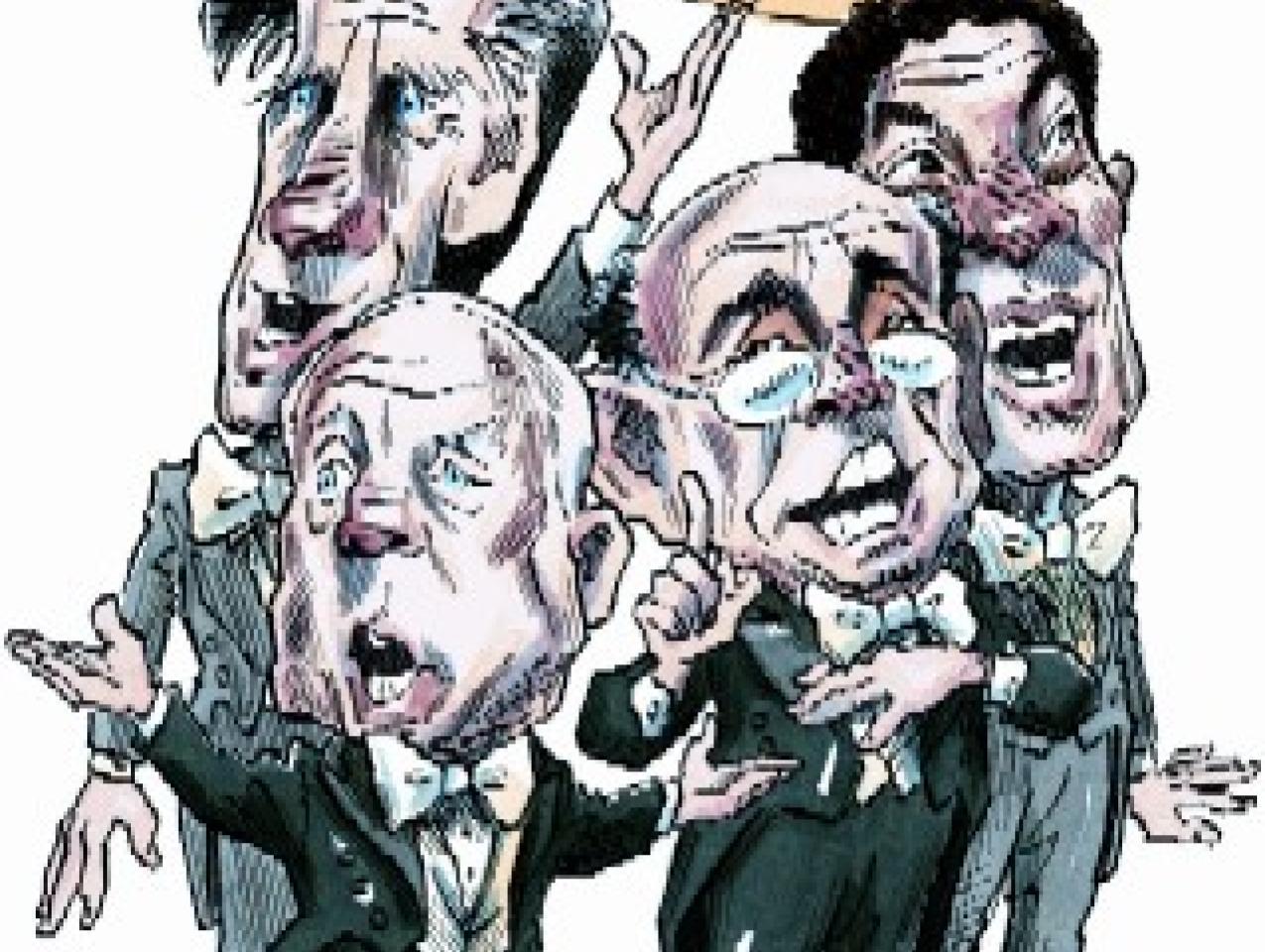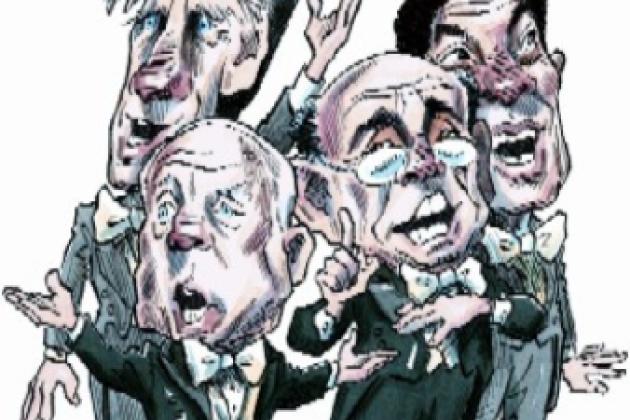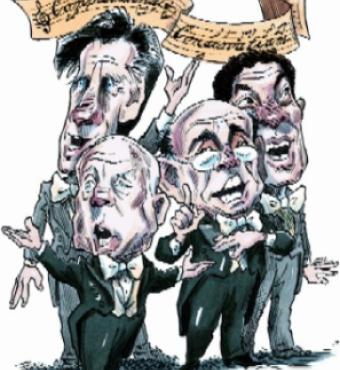- Campaigns & Elections
- The Presidency
- Law & Policy
- Civil Rights & Race
- State & Local
- California
- Budget & Spending
- Politics, Institutions, and Public Opinion
- Economics
Government cannot solve every problem, but it can encourage people and communities to help themselves and to help one another. Often the truest kind of compassion is to help citizens build lives of their own. I call my philosophy and approach “compassionate conservatism.” It is compassionate to actively help our fellow citizens in need. It is conservative to insist on responsibility and on results. And with this hopeful approach, we can make a real difference in people’s lives.—President George W. Bush, April 2002
Compassionate conservatism was a hallmark of George W. Bush’s campaign for president, and it became an important motivator of national and international policy in his first six years in office.
Shortly after the November 7, 2006, congressional elections, a commentator for the conservative magazine Human Events lamented, “Compassionate conservatism failed America and cost Republicans control.” Other traditional conservatives, libertarians, and even some Democrats would make similar arguments, as the nation took stock of the dramatic shift in power that gave both houses of Congress to the blue-state party.
How much of the loss can rightly be pinned on compassionate conservatism? Were the American voters really rejecting Bush’s political philosophy, or were they rebuking his policy choices? Can the two even be separated? Answering these questions is critically important, both for how the president should govern in his final two years and for what role, if any, compassionate conservatism should play in the campaign to elect his successor.
The Origins of Compassionate Conservatism
The perception that Bush created compassionate conservatism is only half-right. What Bush did was to take an obscure theory and make it a household phrase.
The origins of this political philosophy date back to at least 1992, when journalist and professor Marvin Olasky wrote The Tragedy of American Compassion, which critiqued the welfare state as a misguided and harmful government monopoly of aid to the poor. It argued for a return to the pre-twentieth-century system of private and religious charity whereby individuals and local communities met the needs of the poor while holding them accountable. Olasky followed up with Renewing American Compassion in 1996 and Compassionate Conservatism in 2000, the latter, notably, with a foreword by George W. Bush.
“According to the principles of compassionate conservatism, government has a responsibility, not to redistribute the wealth of citizens, but to provide the underprivileged with skills and opportunities to create their own wealth.” So wrote Stephen Goldsmith, former mayor of Indianapolis, who, along with other big-city mayors and governors, championed this approach. Compassionate conservatives differentiated themselves from traditional and cultural conservatives by making concern for the poor a central focus, instead of business, taxes, military strength, family values, or antiliberalism. Not that such values were in conflict with the principles of compassion, but they often left no room for a clear and consistent conservative message on poverty. Thus Republican policies toward the poor had come to be portrayed, in Senator Daniel Patrick Moynihan’s words, as benign neglect.
Compassionate conservatism then began to emerge as a legitimate political system for dealing with a wide range of social ills. Its method and appeal are hinted at in a speech given by then-governor Bush on the campaign trail in 2000:
I am convinced a conservative philosophy is a compassionate philosophy that frees individuals to achieve their highest potential. It is conservative to cut taxes and compassionate to give people more money to spend. It is conservative to insist upon local control of schools and high standards and results; it is compassionate to make sure every child learns to read and no one is left behind. It is conservative to reform the welfare system by insisting on work; it’s compassionate to free people from dependency on government.
COMPASSION IN Government
Reflecting recently in the Wall Street Journal on the role of compassionate conservatism in American politics, Michael Gerson, a former Bush presidential speechwriter, said, “I think it’s a political truth that one reason we won the 2000 election was that Republicans finally had a message on education and welfare.”
| Compassionate conservatives differentiated themselves from traditional and cultural conservatives by making concern for the poor a central focus. |
Newly elected President Bush began implementing his compassionate agenda right away. One of his first political acts was an executive order implementing his Faith-Based Initiative. Opening up federal grant money to religious organizations and treating them fairly was key to a new governing approach that sought to leverage the best private resources, regardless of church ties, to improve lives. The Office of Faith-Based and Community Initiatives within the White House was to be a hub that ensured that compassionate conservatism remained central to policy positions advocated by the administration.
Largely presented as a domestic agenda, many of the president’s signature programs can be tied to compassionate conservatism, notably the No Child Left Behind Act of 2001. From its primary emphasis on educating low-achieving children to its insistence on accountability and testing, NCLB was the poster child for how Bush sought to meld compassion with public policy. But it was also a very large, expensive, and intrusive federally led effort, albeit implemented at the local level. NCLB revealed the Bush White House’s penchant for promoting compassionate governance, leaving by the wayside the conservative values of limiting the federal role and spending less in order to return more to taxpayers.
| Even now, compassionate conservatism meets Democrats on policy turf historically affiliated with liberals—concern for the poor—and offers a legitimate alternative to government dependence. |
A number of other programs fit what Bush called “active government to promote self-government,” the aim of which “is not to spend less money, or more money, but to spend only on what works.” The Medicare Prescription Drug, Improvement, and Modernization Act of 2003 sought to give seniors, especially those in need, more choices and resources to pay for essential medications. Parts of the president’s tax cuts sought to remove the federal tax burden from millions of low-income Americans, giving them more control over their spending. Likewise, Bush put his compassionate stamp on hundreds of social programs administered through HUD, HHS, and other federal branches—including the reauthorization of welfare reform with stronger work requirements, a healthy-marriage initiative, local 10-year plans to end chronic homelessness, and changes to public-housing priorities to encourage home ownership.
In the midst of this domestic-policy overhaul, the September 11 terrorist attacks and subsequent invasions of Afghanistan and Iraq came to dominate the landscape. While the president’s compassionate conservative agenda rightfully took a back seat to national defense, it was clearly not forgotten. Indeed, some have argued, as Gerson
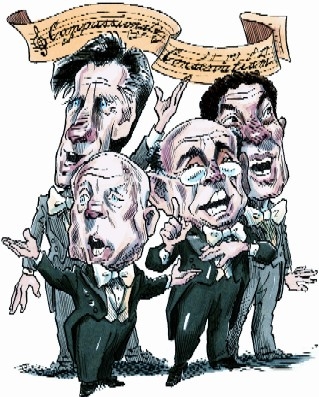
did in an interview with Naomi Schaefer Riley, that “the administration’s foreign policy represents an expansion of the philosophy of compassionate conservatism.” Certainly many of the rhetorical reasons given for the continued U.S. presence in Iraq have a strong compassionate core to them. Besides the safety and security rationales, the president has consistently emphasized how bringing freedom and democracy to the Iraqi people will make for a more peaceful, prosperous, and just society.
The Unraveling of a Grand Experiment?
All this brings us to November 7, 2006, and the Republican defeat at the hands of a resurgent Democratic Party. Some on the right believe that Bush’s compassionate conservative policies alienated a base within the party fed up with his “big government” approach. Former House majority leader Dick Armey said as much just before the election, when he suggested that a Republican loss would be the result of having abandoned the principle of limited government and embraced government for conservative ends. There’s some legitimacy in this critique, especially as it touches on increased federal spending, but it’s a fallacy to pin the blame on compassionate conservatism, for several reasons.
First, the public’s perception of Bush’s Iraq war policy—its justification, implementation, and future resolution—weighed heavy on the minds of voters on election day. People grow weary of drawn-out wars in faraway places. Although some in the administration see the effort in Iraq as an extension of compassionate conservatism, that is a philosophical stretch. It is doubtful anyone would refer to the original implementers of compassionate conservative policies as hawks. A better explanation is that whatever mandate Bush had to pursue his compassionate agenda at home was usurped after September 11 by the neoconservatives within his administration and used to apply military force in support of democratic transition abroad.
Second, the president in many respects failed to heed his own advice to keep spending in check. Bush’s “active government” actively spent from the federal coffers, and not just on national security: real nondefense discretionary outlays increased 7.6 percent annually through fiscal year 2006, above Clinton-era levels (4.2 percent annually) and way above the conservative benchmark set by Ronald Reagan (2.7 percent). It is questionable whether such spending is in line with compassionate conservatism as originally envisioned. In Stephen Goldsmith’s words, set forth during Bush’s candidacy for president,
Fundamentally, compassionate conservatism is a form of political conservatism. In other words, compassionate conservatives believe that government should have a limited role in people’s lives and that competition in the marketplace is the most effective means of producing social and economic progress. Consequently, compassionate conservatives believe in low taxes, limited government regulation, and the vast power of the free-enterprise system.
Third, the midterm elections were not just a backlash against Bush’s policies. To their credit, the Democrats gained seats in many districts by putting forth more moderate candidates than they had before. A New York Times postelection analysis observed that “Democrats have arguably grown more conservative”:
After two decades of defeats, they have largely dropped their former calls for major defense spending cuts, talk of Canadian-style national health insurance, or campaigns for gun control. They work hard to avoid getting tagged as tax raisers, and since 2004 they have tried to open their doors to opponents of abortion as well.
This evolution is certainly no repudiation of the conservative movement or the principles of compassionate conservatism. Rather, it shows the success of conservative ideals and ideas—if you can’t beat them, join them.
| Whatever mandate Bush had to pursue his compassionate agenda at home was redirected after September 11. |
A fourth and final caveat in the blame game is a whistleblower thesis: that the White House deliberately put too little money and muscle behind Bush’s compassionate conservatism. David Kuo, a former deputy director of the Office of Faith-Based and Community Initiatives, argued in 2006 that the faith-based agenda was a political scam to draw in evangelical voters. His book, Tempting Faith: An Inside Story of Political Seduction, presents a picture of cynicism and ridicule toward the compassionate agenda spearheaded by the faith-based office.
Detractors within the administration have been quick to dismiss Kuo’s claims, but they leave two points to ponder. First, if compassionate conservatism was not really a priority within the White House, then it would be difficult to blame it for Republican losses in November. Second, it’s possible the lack of follow-through on compassionate promises kept evangelicals from wholeheartedly supporting Bush and his party in the 2006 midterm election, costing the Republicans dearly.
The Future of Compassionate Conservatism
If compassionate conservatism is not to blame for the Republican loss of the House and Senate, the question remains: does it have any viable role to play in who becomes our next president? If compassionate conservatism is rightly understood and passionately articulated, can a candidate take up its mantle and win?
I believe that compassionate conservatism remains an intellectually coherent and practically sound political philosophy for today’s Republican candidates. Its primary appeal has not changed much since 2000. It meets Democrats on policy turf historically affiliated with liberal causes—concern for the poor—and offers a legitimate alternative to the government-provision mindset. As Myron Magnet of the Manhattan Institute said, “Compassionate conservatism derails the Democratic Party’s greatest rhetorical advantage, its demonstrably empty claim of a monopoly on caring about the worst-off.”
This “take the fight to them” mentality is crucial because the two main elements of the Republican Party, the economic libertarians and the social or religious conservatives, are often so fixated on their own agendas that they end up with no ability to appeal to moderates in their own party, let alone independents and conservative Democrats. Compassion for the poor is a unifying value, the kind that builds majority coalitions.
Yet, if compassionate conservatism were merely a philosophical idea, a feel-good catchphrase, it would be better to let it end with the Bush presidency. Fortunately, it has already proven its mettle in some of the most critical areas of U.S. public policy. Welfare reform has worked. Not only is it more compassionate to lift families out of their dependency on government support than to leave them there, pursuing work over welfare tangibly increases their financial well-being. Likewise, the ability to choose which school a child attends—whether through vouchers, charter schools, or transfers within the public education system—has improved learning, as demonstrated by reform efforts in Florida. In nearly every state and municipality pursuing school choice, the animating principle is an interest in (read compassion for) the welfare of low-income students. Compassionate conservatives also have been leading advocates for tougher law enforcement and harsher criminal penalties, knowing that, as Magnet says, “safer neighborhoods [are] the one thing that most improves the lives of the poor.”
WHERE THE CANDIDATES STAND
So how do the current Republican presidential candidates line up on compassionate conservativsm? As of this writing, the potential field is pushing a dozen, so let’s focus on a select group of front-runners who have already declared their candidacy: former mayor Rudolph Giuliani, Senator John McCain, Governor Mitt Romney, and Senator Sam Brownback.
| Many of the initial Bush programs fit the mold of what the president called “active government to promote self-government.” Its aim: “Not to spend less money, or more money, but to spend only on what works.” |
Giuliani is setting himself up as the Reagan Republican in this election, an advocate for strong defense, low taxes, and the principles of freedom as played out in health care reform and education policy. His support of abortion, gun control, and gay rights rule him out as the favorite candidate of social conservatives, but these issues are not central to the compassionate conservative agenda. What Giuliani can run on are his successful efforts to improve the lives of New York City’s poor through welfare reform and crime reduction, and his own conviction that conservatives care more for the poor than do liberals because their policies actually improve lives. Giuliani is well-positioned to rekindle the original appeal of compassionate conservatism.
McCain and Romney are both serious candidates who so far have failed to evince serious conviction about the issues central to compassionate conservatism. McCain lost to Bush when the Texas governor was the compassionate candidate, and there is little to suggest his priorities have changed. McCain is spending most of his time appealing to the social-conservative base he alienated in the last presidential election and aligning himself with Bush and the few remaining pro-war neoconservatives. Romney is in a similar position, articulating a staunchly conservative social agenda that bears little resemblance to his actions as governor of the blue state of Massachusetts. His compassionate conservative side has yet to be revealed.
It’s possible that both McCain and Romney are pursuing campaign strategies that they believe will win them the nomination—tactics initially focused on the religious base of the Republican Party.
Brownback is an interesting contrast to the three others. He has a more authentic social-conservative perspective, but also has been the most vocal about compassionate conservatism thus far. In announcing his candidacy, Brownback said, “There is a real need in our country to rebuild the family and renew our culture, and there is a need for genuine conservatism and real compassion in the national discussion.” In addition, he has strongly endorsed programs (including faith-based ones) to help prisoners reintegrate into society, to offer international aid to combat HIV/AIDS, and to provide guest-work programs for immigrants. What remains unclear is whether Brownback’s compassionate positions are an extension of President’s Bush’s approach, or a return to the compassionate conservatism that stresses the free market and limited government.
In all likelihood, one of these candidates will win the Republican nomination and face a formidable Democratic opponent. We may have to wait until the two-way race gets under way to fully appreciate the appeal compassionate conservatism still has for the American voter.
The Bush presidency has certainly elevated compassionate conservatism to a national level, but this political philosophy has deeper roots than those tapped so far. The capacity of Americans to support each other on an individual level, without government assistance or interference, remains undervalued. The power of faith to move people both to serve and to be healed of old wounds remains hidden from the public square. The hope that springs from the release from government dependency remains unknown to millions of citizens. True compassion awaits its champion.








